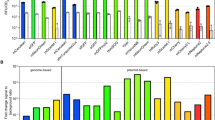Abstract
The utility of the green fluorescent protein (GFP) as a probe to monitor protein localization in living cells is gaining a great deal of attention. In this study, to understand the localization of luciferases in E. coli, we have attached GFP tags at both the N- and the C-terminus of firefly luciferase (FF-Luc) (from Pyrocoelia miyako) and of red (RE-Luc) and green (GR-Luc) bioluminescence-emitting luciferases (from Phrixothrix railroad-worms), respectively. There was no significant change in the bioluminescence emission spectrum for any of the three luciferases following the tagging with GFP at either the N- or C-terminus, confirming the absence of energy transfer between one another. Using confocal imaging microscopy, we observed that all three luciferases expressed in the E.coli cultured at 37 °C tend to aggregate and are seen to localize in the poles, thus confirming their poor folding properties. In contrast, in the E.coli cultured at 18 °C FF-Luc was found to be highly expressed in the soluble form when compared to RE-Luc and GR-Luc. These results support our previous finding that the folding properties of FF-Luc and RE/GR-Luc are totally different.
Similar content being viewed by others
References
M. Chalfie and M. Au, Genetic control of differentiation of the Caenorhabditis elegans touch receptor neurons, Science, 1989, 243, 1027–1033.
C. M. Southward and M. G. Surette, The dynamics microbe: green fluorescent protein brings bacteria to light, Mol. Microbiol., 2002, 45, 1191–1196.
S. J. Rosochacki and M. Matejczyk, Green fluorescent protein as a molecular marker in microbiology, Acta Microbial. Pol., 2002, 51, 205–216.
J. C. Chen and J. Bechwith, FtsQ, FtsL and FtsI require FtsK, but not FtsN, for co-localization with FtsZ during Escherichia coli cell division, Mol. Microbiol., 2001, 42, 395–413.
A. Zaritsky and C. L. Woldringh, Localizing cell division in spherical Escherichia coli by nucleoid occulusion, FEMS Microbiol. Lett., 2003, 226, 209–214.
J. L. Casey, A. M. Coley, L. M. Tilley and M. Foley, Green fluorescent antibodies: novel in vitro tools, Protein Eng., 2000, 13, 445–452.
B. Feilmeier, G. Iseminger, D. Schroeder, H. Webber and G. J. Phillips, Green fluorescent protein functions as a reporter for protein localization in Escherichia coli, J. Bacteriol., 2000, 182, 4068–4076.
A. E. Pouli, H. J. Kennedy, J. G. Schofield and G. A. Rutter, Insulin targeting to the regulated secretory pathway after fusion with green fluorescent protein and firefly luciferase, Biochem. J., 1998, 331, 669–675.
J. Lehtinen, M. Virta and E. M. Lilius, Fluoro-luminometric real-time measurements of bacterial viability and killing, J. Microbiol. Methods, 2003, 55, 173–186.
V. Sourjik and H. C. Berg, Localization of components of the chemotaxis machinery of Escherichia coli using fluorescent protein fusions, Mol. Microbiol., 2000, 37, 740–751.
O. Olsson, A. Escher, G. Sandberg, J. Schell, C. Koncx and A. A. Szalay, Engineering of monomeric bacterial luciferases by fusion of luxA and luxB genes in Vibrio harveyi, Gene, 1989, 81, 335–347.
Y. A. Yu, T. Timiryasova, Q. Zhang, R. Beltz and A. A. Szalay, Optical imaging: bacteria, viruses and mammalian cells enconding light-emitting proteins reveal the locations of primary tumors and metastases in animals, Anal. Bioanal. Chem., 2003, 377, 964–972.
L. F. Greer, III and A. A. Szalay, Imaging of light emission from the expression of luciferases in living cells and organisms: a review, Luminescence, 17(1), 43–74.
V. R. Viviani, A. J. S. Neto and Y. Ohmiya, The Influence of the region between residues 220 and 334 and beyond in Phrixotrix rail road work luciferase green and red bioluminescence, Protein Eng., 2004, 17, 113–117.
Y. Nakajima, M. Ikeda, T. Kimura, S. Honma, Y. Ohmiya and K. Honma, Bidirectional role of orphan nuclear receptor RORalpha in clock gene transcriptions demonstrated by a novel reporter assay system, FEBS Lett., 2004, 565, 122–126.
S. J. Gould, G. A. Keller, N. Hosken, J. Wilkinson and S. Subramani, A conserved tripeptide sorts protein to peroxisomes, J. Cell Biol., 1989, 108, 1657–1664.
E. A. Nollen, F. A. Salomons, J. F. Brunsting, J. J. Want, O. C. Sibon and H. H. Kampinga, Dynamic changes in the localization of thermally unfolded nuclear protein associated with chaperone-dependent protection, Proc. Natl. Acad. Sci. USA, 2001, 98, 12038–12043.
S. Zietkeiwicz, J. Krezewska and K. Liberek, Successive and synergistic action of the hsp70 and hsp100 chaperones in protein disaggregation, J. Biol. Chem., 2004, 279, 44376–44383.
V. R. Viviani, E. J. Bechara and Y. Ohmiya, Cloning, sequence analysis, and expression of active Phrixothrix railroad-worm luciferases: relationship between bioluminescence spectra and primary structures, Biochemistry, 1999, 38, 8271–8279.
B. Venkatesh, M. Arifuzzaman, H. Mori, T. Taguchi and Y. Ohmiya, GroEL chaperone binding to beetle luciferases and the implication for refolding when co-expressed, Biosci., Biotechnol., Biochem., 2004, 68, 2096–2103.
P. A. Pillon, P. Gauthier, P. Balaguer, A. Pelegrin and J. C. Micolas, Bioluminescent imaging: applications to cancerology and endocrinology, J. Soc. Biol., 2004, 198, 157–161.
Y. A. Yu, S. Shabahang, T. Timiryasova, Q. Zhang, R. Beltz, I. Gentschev, W. Goebel and A. A. Szalay, Visualization of tumors and metastases in live animals with bacteria and vaccinia virus encoding light-emitting proteins, Nat. Biotechnol., 2004, 22, 313–320.
Author information
Authors and Affiliations
Corresponding author
Additional information
Presented at the 14th International Congress on Photobiology, at Jungmoon, Jeju Island, South Korea, 10th-15th June 2004.
Rights and permissions
About this article
Cite this article
Venkatesh, B., Arifuzzaman, M., Mori, H. et al. Use of GFP tags to monitor localization of different luciferases in E. coli. Photochem Photobiol Sci 4, 740–743 (2005). https://doi.org/10.1039/b416747c
Received:
Accepted:
Published:
Issue Date:
DOI: https://doi.org/10.1039/b416747c




